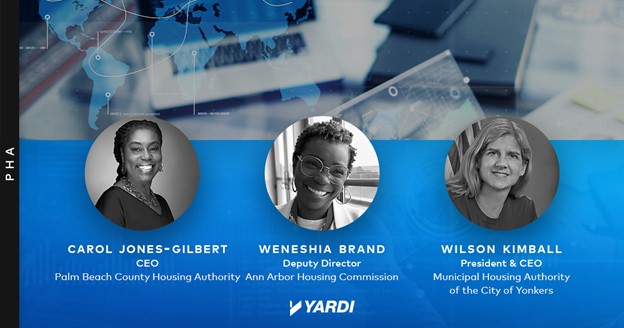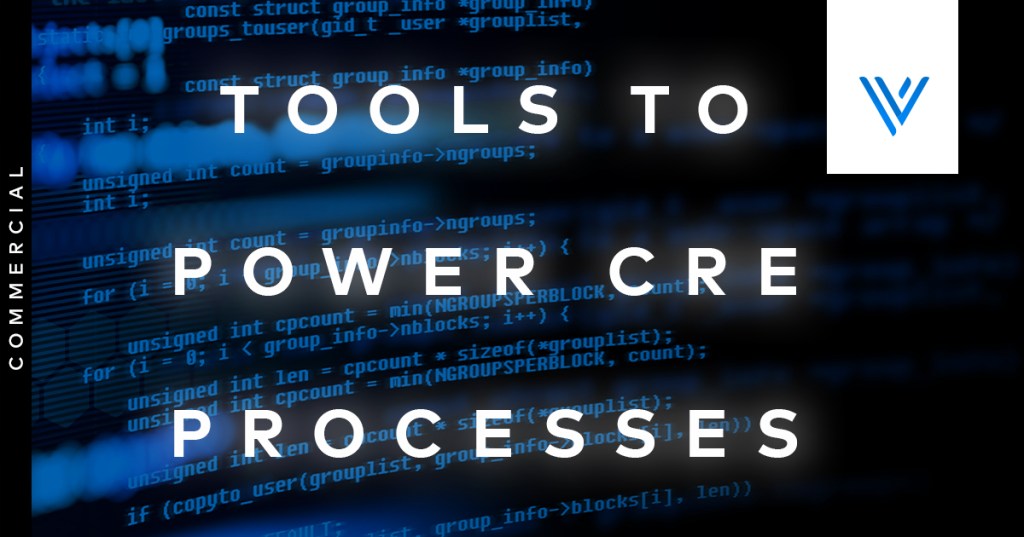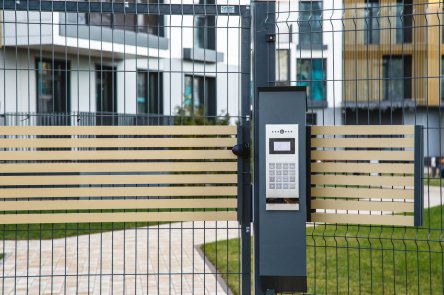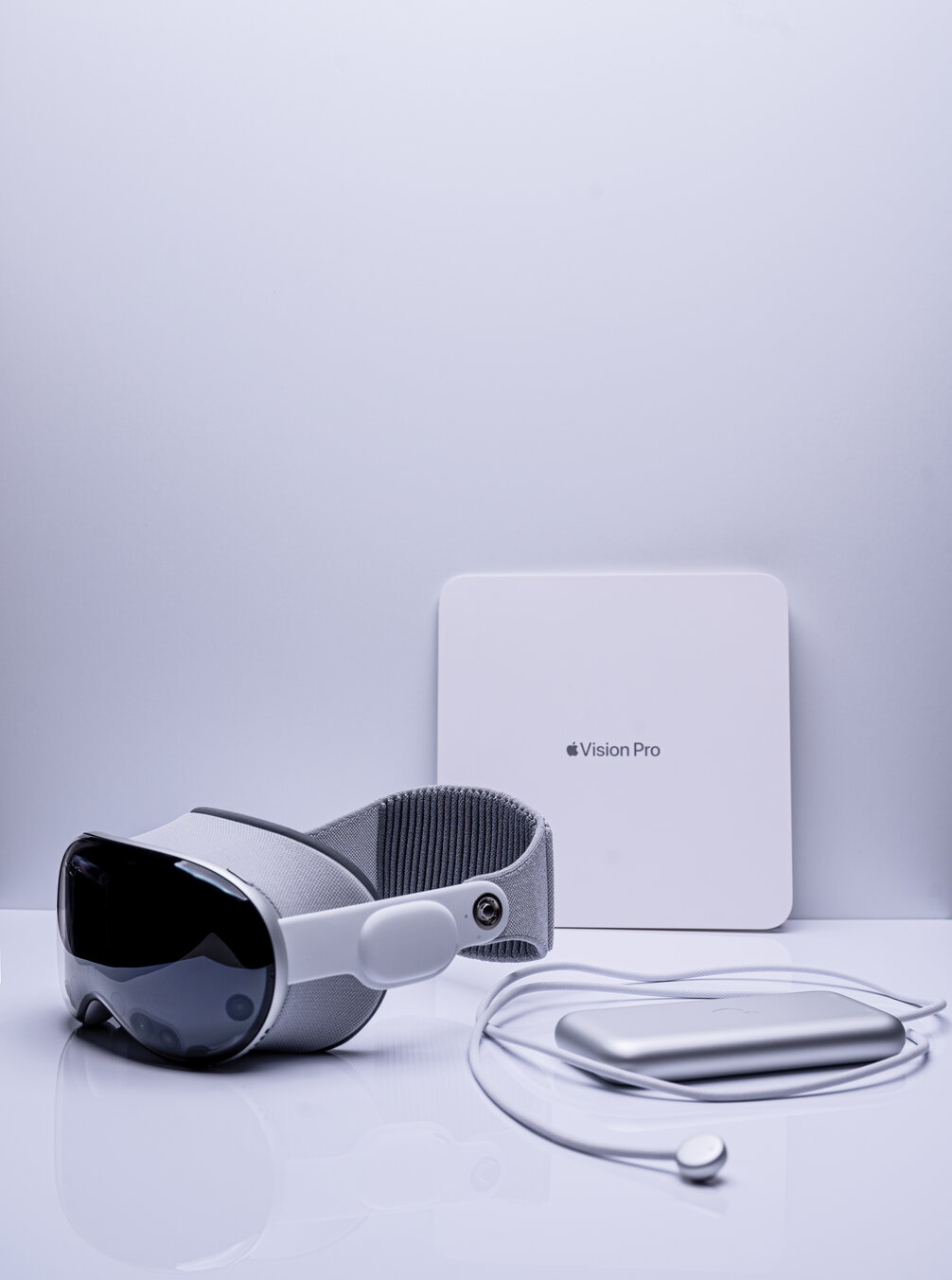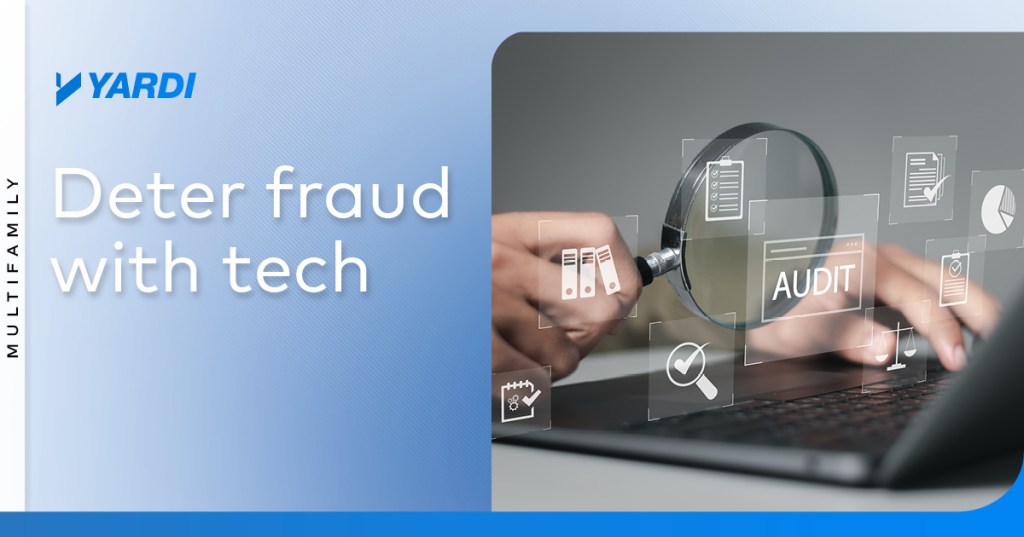Connecting accurate information to support budgeting, leasing and construction projects is essential to optimizing CRE asset performance. Working with the right set of software tools not only ensures transparency and data accuracy but also provides real-time and actionable insights. For example, when live data from the leasing pipeline and construction projects are available within your budgeting solution, you can manage forecasts on a rolling basis without the hassle of updating spreadsheets. So what’s the best practice? Using a single stack solution with a single source of truth and real-time data access. From lead-to-lease pipeline management to streamlining the budgeting process and optimizing the construction lifecycle, connected solutions with seamless dataflow and automated workflows can unlock operational efficiency. Side-by-side comparisons and real-time budget tracking Yardi Forecast Manager is a full-featured software solution that enables clients to monitor annual budget performance relative to their approved budget. Clients can promote deals from Yardi Deal Manager to Forecast Manager and use re-forecasting to accurately analyze their budget based on all deals in the pipeline. A built-in hover-over feature in the forecasting tool shows where a particular data set originated and clients can make necessary adjustments along the way. Correspondingly, Deal Manager incorporates settings that ensure the appropriate information is pushed to Forecast Manager. When it comes to assessing risk, clients have access to a comprehensive view of their portfolios in both Deal Manager and Forecast Manager and they can filter and view a wide range of information about each space — even across properties — including tenant risk and lease expiration date. As an additional benefit, Forecast Manager enables clients to easily identify deals (when they also use Deal Manager) at a particular stage and promote them into the forecast. A deal can be included in the budget by simply clicking the “promote” button next to the deal. Promoting the deal means that it will be included in the worksheet the next time the client runs the forecast or revenue projection. No more tedious spreadsheets This combination of features and integration of deal pipeline data helps asset management and operation teams budget more accurately and eliminates the need for manually compiling various spreadsheets. Industry leaders using Forecast Manager are seeing results. Rexford Industrial quickly discovered the benefits of using a connected software solution to optimize the CRE revenue lifecycle. “Our forecasting is correct the first time and easy to see on a dashboard. I can add acquisitions and quickly get a snapshot of what the acquisition will do many quarters out. All this used to take days, and now it takes 15 minutes,” said Alex DeHaven, VP of Corporate Finance, Rexford Industrial. Learn more about Yardi Forecast Manager and hear how it’s working for Rexford...
School’s In
College Tech Necessities
Technology for college students used to mean lamps, typewriters and alarm clocks. Essential items for thriving in today’s higher education environment include: Laptop. “Small screen touch notebooks are a great solution for everyday computing and entertainment around the dorm or apartment, or on the go from class to class,” said Scott Shutter, a senior manager for computing, graphics and visualization technology provider AMD in Austin, Texas. Tablet. With some textbooks being formatted for eReaders, it might make economic sense to get a tablet in addition to a laptop. “I have all my textbooks, take all my notes and store assignments on [a tablet],” said Brian Kearney, a student at Rowan University in New Jersey. “It has truly helped me in organizing my hectic college schedule.” A key accessory for tablet owners is a stylus, an active digitizer that enables note-taking on both tablets and 2-in-1s, which combine tablets and notebooks. Smartphone. Virtually every student wants a smartphone equipped with the latest operating system and relevant apps. Most professors and student groups send mobile updates to smartphones. Smart notebook. This device digitizes handwritten notes for later reference. Some models offer a paper-like writing and reading experience and syncs notes to the cloud for access across multiple devices. Digital audio recorder. This is useful for recording lectures for later transcription or review. “With transcription software, students can write papers without touching the keyboard, significantly speeding up their work. Portable charger. This helps keep all devices powered up throughout the day without the need for a wall outlet. Data storage. Flash drives hold data for access on the go. An external drive or cloud storage provides backup storage. Backup computer battery and power cord. Just in case the unthinkable happens, such as a power outage or a...
Meet Yardi Case Manager
Q&A with Mark Livanec
Yardi Case Manager was introduced in 2023 and is one of the newest solutions integrated within the Yardi Affordable Housing Suite. Let’s learn more about it from Yardi Affordable Housing Industry Principal Mark Livanec. Mark, let’s start at the beginning. Tell us what a case is. Cases are any situation, ticket, or task that requires property managers or resident service staff to track and resolve. The flexibility of defining and managing case resolution workflows is one of the things I like most about Yardi Case Manager. Affordable housing providers have a lot of flexibility and powerful ticketing tools that will help them track the services they provide daily. There is also flexibility in how cases are created given Case Manager’s integration with the Yardi Affordable Housing Suite. A resident can create a case using their RentCafe Affordable Housing app on their mobile device, eliminating the need to make a phone call or visit the front office. There’s even automation built in that creates a set of tasks and team assignments necessary to resolve each case that come in from various sources. What’s the main reason Yardi clients should add Case Manager? Integration with Yardi Voyager, including our upcoming solution Compliance Manager powered by Voyager 8, make Case Manager a prime opportunity to strengthen affordable housing compliance without complicated workflows. Affordable housing programs are highly scrutinized by the federal, state and local funding programs. Yardi Case Manager can help keep providers in compliance by tracking service requests, reasonable accommodation requests, the work done to accommodate requests and how each case is resolved. How does tracking cases mitigate risk? One important example is fair housing, which includes laws that ensure affordable housing providers treat applicants and residents equally. Throughout the resident lifecycle, affordable housing providers need to document their interactions with every household they serve. When it comes to tacking and following through on requests, Yardi Case Manager is a great tool to keep everything consistent for everyone. Similarly, several laws require housing providers to accommodate reasonable requests for modifications to forms and living spaces. For example, applicants or residents may need special equipment installed in a unit because of a physical disability, others may need forms translated to a specific language. Not providing a reasonable request to make housing physically accessible can raise red flags with auditors and can lead to litigation. Yardi Case Manager is designed to make sure affordable housing site staff not only record the request for reasonable accommodation but serves as a tool to document follow-through efforts. Without proper documentation, your organization can be at risk of fair housing litigation. Domestic violence situations are another type of case that requires special attention and extreme confidentiality. Yardi Case Manager enables affordable housing providers to keep certain cases private and, on a need-to-know basis, to keep everyone safe and prevent unlawful disclosures. Why Yardi Case Manager when there are already prospect and resident records in Yardi Voyager? Yardi Case Manager has workflows that are specifically optimized for service delivery staff. That functionality can help keep things simple and effective since it’s easy to train, configure and use throughout the workday. There is, of course, integration with Yardi Voyager for access to cases through the upcoming Compliance Manager, powered by Voyager 8 dashboard. Cases can be tied to specific members of a household record, and notes from maintenance techs and inspectors can be copied to cases. But, if an affordable housing provider prefers to keep Yardi Case Manager as a tool primarily in use by their resident service coordinators and other front-line site staff, that works as well. How can Yardi Case Manager expand to help cover more types of requests? Case types can be configurable to unique request scenarios for applicants, residents, vendors/landlords, and even employees. Service coordinators can track case progress from start to finish via customizable tasks, team assignments and reports. The table below gives examples...
YASC Multifamily Spotlight
40 Years of Innovation
2024 is a big year for Yardi, and it’s not just because we’re celebrating 40 years in business. This year marks an exciting shift in our innovation process, exemplified by the new AI solutions presented during YASC 2024’s opening spotlight session for multifamily. Here’s a recap of innovations and features unveiled during the event. Marketing with AI Ready to streamline content creation and optimize marketing spend? As Esther Bonardi, Yardi vice president of corporate marketing and REACH by RentCafe, put it, “AI is everywhere, and it’s impacting all of our development from the time renters start looking for their apartment, and all the way until they’re renewing their lease.” Here’s a peek at new AI-driven solutions to help you drive more quality prospects. Simplifying content creation with Creator by Virtuoso The new Creator by Virtuoso — included in Marketing IQ Genius — uses AI to generate and schedule content for property websites. Whether it’s page narratives, blog posts or Google Business Profile updates, content creation has never been easier. Marketers can now update websites and social feeds with minimal effort, ensuring they stay competitive in the digital landscape. Data-driven budgeting and strategy Marketing IQ Genius also includes more advanced SEO and PPC reporting, as well as PPC budget recommendations powered by machine learning. Get strategic suggestions that help you make informed decisions about your advertising spend. Allocate budgets more effectively and drive better results based on real-time data and insights. Speed to lease: Accelerating the customer journey with AI “Days equal dollars when it comes to vacancy loss,” Paul Yount, industry principal, said to a crowd of multifamily professionals — but not before he somehow weaved a baby picture of himself onto a slide. (It all connected to his YASC session, “Back to the Future of Leasing and AI.”) Speed is everything when it comes to turning your prospect into a resident — and our AI initiatives are making that process even faster. Here are some updates that will help you reduce vacancy loss. More efficient leasing Chat IQ, powered by Yardi Virtuoso, provides instant, personalized responses to your customers that keep them engaged and informed throughout their leasing journey. Plus, our income and identity verification solutions streamline approvals, ensuring maximum speed when it comes to converting an inquiry into a lease. Self-serve maintenance Our new self-serve maintenance feature guides residents through minor fixes, reducing the hassle associated with maintenance and the workload on property managers. This not only enhances resident satisfaction but also frees up time for teams to focus on more strategic tasks. Yardi Energy Yardi Energy has exciting new updates in store to help you manage energy usage more efficiently, so you can reduce cost while aligning with environmental best practices. Enhancing the resident experience We’re also rolling out new innovations that will make your resident experience even better. Get ready for increased resident satisfaction and renewals. Rewards by RentCafe Resident retention is key to long-term success, and our new rewards program for residents is designed to do just that. Rewards by RentCafe incentivizes your residents to pay rent on time by rewarding them for on-time rent payments and subscriptions to Resident Services by ResidentShield. Points can be redeemed for fun things like travel and shopping, helping you enhance satisfaction. Resident Services by ResidentShield As just mentioned, we’ve rolled out a comprehensive suite of resident services that cater to every stage of the resident lifecycle. But the highlight is our move-in tracker, which simplifies the move-in process for residents by giving them one place to sign up and activate all the essentials, like Wi-Fi and electricity. This helps them feel at home from day one, and gives you bonus points for a seamless experience — without extra effort on your part. The roadmap A preview of enhancements you can take advantage of now, or soon! Chat IQ It just keeps getting better with Chat IQ. This...
Tenant Insurance Compliance...
Optimizing COI Tracking
It might seem straightforward to require that tenants provide proof of insurance when a lease is signed. However, managing a Certificate of Insurance (COI) for every tenant along with insurance policy endorsements and ensuring continuous coverage can be very challenging. Read on for a deeper dive with tips to successfully overcome challenges for maintaining tenant compliance. Why COIs matter A COI is a document issued by an insurance company that summarizes the insurance policies held by a tenant. It outlines the coverage limits, policy durations and other relevant details. Additional insured and subrogation information is outlined in the policy endorsements. Closely managing COIs is essential for landlords to verify that their tenants maintain adequate insurance coverage to protect against potential risks. COI management challenges throughout the lease lifecycle One of the primary challenges faced by landlords is ensuring the timely receipt and verification of COIs from tenants. Tenants may delay submitting the COIs or fail to provide the required coverage details. This delay can impede lease execution or expose the landlord to increased risks for leases already signed. Landlords often have specific insurance requirements for their commercial properties. These requirements may include minimum coverage limits, additional insured endorsements and specific policy provisions. Ensuring that tenants comply with these requirements can be difficult, as some tenants may struggle to find insurance policies that meet the landlord’s criteria. COI management involves tracking policy expiration dates and ensuring that tenants renew their insurance policies before they lapse. Monitoring policy expirations for multiple tenants can be time-consuming and prone to human error, potentially leaving the landlord exposed to liability if a tenant’s insurance coverage expires. Another challenge landlords face is the possibility of tenants providing COIs with inadequate coverage or insufficient policy limits. In such cases, the landlord...
Shaping Tomorrow’s PHAs
With Innovation and technology
The housing crisis isn’t going away overnight, but with the power of innovation and technology, people can get housed faster and smarter. That’s why public housing authorities (PHAs) are stepping up to the challenge. We had the privilege of sitting down with some visionary authorities to discuss their plans, and to say we were inspired is an understatement. These agencies understand they need to adapt to meet the changing needs of their community. Leaders in the industry are taking the leap towards implementing technology and transforming their operations — even if it means dipping their feet into an area they aren’t familiar with. By choosing innovation, they’re setting the bar high for public housing authorities — proving that with the right tools and mindset, we can overcome the most daunting challenges. Their commitment to change is paving the way for a brighter future where all families can find safe and affordable housing. “We’re striving to be innovative in our use of technology and development of affordable housing units. We must think outside the box. It’s critical for housing authorities to reinvent themselves and become community leaders. And Yardi has been critical in helping us take that leap,” says Carol Jones-Gilbert, CEO of Palm Beach Housing Authority. In this article, you’ll learn how agencies are using innovation to: Prioritize residents in their operations Navigate the challenges of the PHA world Plan and prepare for the future Putting residents first It’s no secret that there are many moving parts in getting applicants approved for public housing. From managing waitlists to ensuring compliance, the process can be daunting and time-consuming. But agencies are moving forward as technology evolves. Paper processes are a thing of the past, and innovation is the new gold standard. With trusted software, agencies are prioritizing the needs and happiness of their residents. After all, assuring residents receive the support they need is paramount to the goals of public housing agencies. We caught up with Weneshia Brand, deputy director of the Ann Arbor Housing Commission, and discussed her success with Yardi. She explained how they continually strive for excellence in all aspects of their operations and want to set the bar high for other agencies to follow. She championed the simplicity of handling all their business in one platform, including their maintenance, reporting and financial activity. “With Yardi, we can manage our maintenance requests, financial records and compliance reports all in one place,” she offered. These integrations have saved her team hours while also reducing the risk of errors and increasing overall efficiency. But what’s most important is that, with innovation on the rise, agencies can focus on what really matters: the residents. Staff members can now dedicate time to more hands-on tasks, such as maintenance requests, property inspections and personalized support programs. The innovation doesn’t stop here for the Ann Arbor Housing Commission. Brand disclosed her plans to implement Yardi Case Manager. Their interest stems from the desire to be part of the continuum of care. “The case management system will allow us to process our homeless individuals more quickly, ensuring they receive the support they need,” Brand explained. This progressive approach confirms their commitment to leveraging technology to better serve their community and get more people housed. Keeping up with the ever-changing PHA world Public housing agencies are doing incredible work to keep up with the evolving PHA space. They’re navigating a complex web of regulations, adapting to shifting policies and managing staff turnover — all while ensuring their residents are receiving the care they deserve. Let’s be honest, compliance with HUD regulations can cause headaches for many agencies. Navigating the complexities of changing policies at the federal level, staff turnover and compliance work requires dedication and hours of planning. Among these dedicated agencies is the Palm Beach Housing Authority, which has leaned on Yardi to stay compliant and expand the areas they serve. In fact, their...
Succession Planning with Yardi Aspire
For Public Housing Authorities
Public housing authorities (PHAs) across the U.S. are facing a major challenge: many of their employees are getting close to retirement. It’s estimated that over 50 percent of PHA and other public sector employees could retire within the next five years. This means PHAs need to have a plan in place to fill these upcoming vacancies with qualified people. However, it’s not easy — 79 percent of agencies cannot find qualified candidates for open positions, according to a survey by NeoGov, an HR solution provider for the public sector. Succession planning is crucial for PHAs. It’s not just about finding someone to fill a job — it’s about keeping a skilled workforce that can serve their communities effectively. A good succession plan can also lead to better employee retention and engagement. In fact, organizations with strong plans have retention rates 50 percent higher than those without them. To tackle these challenges, PHAs must ensure their staff possess the right skills and knowledge to step into leadership roles when needed. The Yardi Aspire Learning Management System (LMS) is a powerful tool that can help. Aspire delivers effective industry education, skill development and promotion preparation — helping PHAs build a strong pipeline of talent and ensuring smooth leadership transitions. Why succession planning matters Succession planning involves looking ahead and being prepared. According to the HUD Instructional Guide, succession planning helps PHAs in several key ways: Ensures long-term success: Confirms that PHAs maintain smooth service delivery, even during leadership changes. Reduces risks: Identifies important roles and prepares internal candidates when key positions become vacant. Promotes staff growth: Promotes staff development and prepares them for leadership roles, ensuring the right skills are in place. How Aspire supports succession planning Aspire offers several tools that are vital for effective succession planning, such as: Extensive catalog: Offers hundreds of short, interactive courses designed to fit within a busy workday from the LMS or on a mobile device with the Aspire App. The Aspire catalog covers a variety of training topics, including industry knowledge, fair housing and sexual harassment, safety, Yardi software, leadership, professional skills and more. PHAs can also create custom courses to ensure organization-specific learning needs are covered. Assess and develop internal talent: Evaluate your current workforce to identify high-potential employees who could fill key roles in the future with Aspire assessments. Then, map out the key skills needed for each role included in the strategic plan. Configure Aspire to automatically deliver or recommend development opportunities to equip these individuals with the necessary skills and knowledge. These include offering training, mentorship and leadership development assignments — all of which can be set up and tracked in Aspire. IMAGE: Skills assigned report shows a Seattle Housing Authority employee’s progress toward assigned skill proficiency. Custom Learning Plans: Aspire’s embedded authoring tools allow succession plan teams to create custom learning plans that align with their succession goals. These plans clarify the promotion path, which often includes a variety of tasks, learning assignments, forms and surveys and assessments to make sure employees are fully prepared for future roles. External Certifications: Aspire helps PHAs stay compliant with HUD requirements, which is especially important during leadership transitions. In addition to assigning hundreds of short, program-specific courses for Low Income Housing Tax Credit (LIHTC), Section 8, and Enterprise Income Verification (EIV), Aspire clients can upload 3rd party training (i.e., industry certifications) and schedule annual recertification. Comprehensive Reporting: Use the interactive dashboards and scheduled reports to ensure that the required skills and competencies are in place and necessary certifications are up to date. Implementing a succession plan with Aspire Identify Key Roles: Start by identifying the roles that are crucial for your PHA’s operations. Aspire can help document the responsibilities and skills needed for each role. Develop Potential Successors: Use Aspire to create and track personalized development plans for potential successors. These plans can include opportunities to earn badges and rewards, keeping...
How AI is Reshaping CRE
Tech You Can Implement
AI is top of mind across the real estate industry, and the business case for AI in CRE has become clear. CRE stakeholders embracing AI’s impact on the industry are already employing data-driven approaches to decision making while leveraging AI to improve day to day operations including optimized AP processing and customer service. Following are three ways AI is revolutionizing CRE with tech you can implement now. Chatbots A chatbot is any software solution that simulates conversation using natural language through text or voice interaction. OpenAI’s ChatGPT, Google’s Gemini, Meta’s Llama and Anthropic’s Claude are examples of large language models (LLMs), which draw on vast amounts of data to predict the next word and answer a question or suggest a solution to a problem. Common uses for ChatGPT include writing emails, proofreading and other everyday tasks. Businesses are employing chatbots most often for customer service. In the multifamily sector, owners are using this type of AI to respond to resident questions and maintenance requests, as well as to provide prospects with information about properties. Research shows that a smart chatbot can significantly reduce the number of days it takes to convert a lead to a lease. With regard to saving staff time and optimizing efficiency for maintenance processes, during a call to report a clogged sink, for example, a chatbot can take the resident through steps to resolve the problem before issuing a maintenance request or connecting them with a property team member. Managers at office, retail and industrial properties can use ChatGPT in similar ways. Yardi employs ChatGPT in its natural language processing solution to improve the accuracy of its responses to client questions. Yardi’s chatbot now resolves 80 percent of inquiries that previously required the attention of a customer service representative. As a result, team members are freed up to tackle requests and issues where solutions aren’t readily available and more expertise is required. Web content solutions A widespread lack of website compliance with the Americans with Disabilities Act (ADA) touched off a wave of federal legal challenges beginning in 2018. By creating environments where website users can participate equally, operators can avoid this legal risk and foster seamless interaction with digital content. In recent years, emerging AI platforms in web development have begun to provide solutions to address ADA compliance issues, according to Equally AI, a developer of website accessibility software. Screen readers and natural language processing can analyze and interpret web content, providing auditory cues to assist users with visual impairments, for example, while conversational AI speech recognition capabilities allow users with mobility impairments to interact with websites through voice commands. AI-powered captions and transcriptions provide similar benefits to those with hearing problems. Other solutions include AI-driven interface enhancements such as adaptive design and intelligent navigation, which can adapt websites based on user preferences and behaviors. Machine learning In recent years, Yardi employed a full-service invoice processing center for 60 million annual client invoices, where teams would manually scan, key and code invoices into client environments. This would then initiate the workflow for invoice approval. But over the last three years, the company has migrated that activity to machine learning. Vendor names, invoice numbers and line item details are now encoded into the accounting systems for fully automated processing. Employing machine learning to this tedious, time-consuming task has not only improved accuracy but has also produced cost savings, which Yardi is passing onto clients. “These are very simple tasks, but the machines need a lot of data and experience to achieve a high level of accuracy,” said Brian Sutherland, a Yardi vice president. “We certainly have that data at scale.” Similar endeavors Yardi is working on include a lease extraction solution. That will pair machine learning with a chatbot to identify, collect and organize lease expiration dates, rent step-ups, options and other pertinent information that is typically buried in dense contract verbiage, making it difficult...
1 Million Units of Chat IQ
Top Choice for Owners + Operators
Chat IQ is helping one million units with seamless communication! To celebrate this milestone, we spoke with Chat IQ’s biggest fans: Top property managers in the industry. Discover why the industry loves this powerful bot and how it all creates a domino effect when it comes to driving efficiency in their organization. Backing it up with the numbers “We’re thrilled about the unit milestone,” said Paul Yount, industry principal at Yardi. “It means that our valued clients trust us with their AI bot needs.” This year to date, Chat IQ has handled over four million inbound messages for our clients and their agents. This resulted in over 225,000 hours saved, according to Yardi data. One of the standout benefits is the improvement in what Yount refers to as “speed to lease,” or the time it takes for a prospect to become a resident. Chat IQ accelerated the time it took for a prospect to sign a lease by up to seven days. “Days equal dollars when it comes to vacancy, so this is really improving not just the efficiency of the onsite teams, but the community and client’s bottom line,” Yount concluded. About Chat IQ Chat IQ answers prospect and resident questions around the clock through chat, email, text and calls. It frees up your staff to focus on higher-level activities they enjoy more than answering repetitive questions. Chat IQ instantly answers almost all customer base intents, connects customers to real agents if needed and now includes support from Yardi when your agents are unavailable. Our clients say it best Chat IQ has garnered praise from top property managers for its outstanding performance and benefits it brings to their operations. Here are some of the key advantages that make this AI-powered bot an industry favorite. Enhanced efficiency Chat IQ can answer 97 percent of questions without needing to learn anything new, eliminating the need for constant data reentry. Carrie Bakke, senior systems analyst at the Lund Company, shares her experience, stating, “In the first six months after we rolled out Chat IQ, we had an average of three leases per month that were generated entirely from the bot. It freed up approximately six hours a day spent answering questions. And all of that information has been provided without our site teams having to lift a finger.” Freed up time for leasing agents Chat IQ allows community team members to do more valuable and meaningful work, while providing the immediacy today’s consumers expect. “Chat IQ is there day or night, business day or holiday,” said Yount. The ability to operate around the clock has made a significant impact on leasing teams. Leslie Henry, SVP at Towne Properties, notes, “After we implemented Chat IQ, our site teams quickly realized how useful it was in gaining back time. They love how it filtered out less promising leads in the beginning. We let them customize some aspects of the responses so there was more of a personal human touch.” Proven ROI For others, Chat IQ is simply about the return on investment. Jason Gherardini, SVP of IT at Sares Regis Group, highlights the value Chat IQ brings, saying, “We get true ROI with Chat IQ from the first conversation, discussion, all the way to lease. It’s a good product.” And it’s getting even better with a new AI update We’re excited to announce that Chat IQ is now more efficient, more impactful and more streamlined with several AI enhancements: Customizable brand tone: Chat IQ matches your company’s unique voice and style, creating consistency in each conversation. OpenAI ChatGPT integration: Prospects and residents will enjoy more natural, human-like interactions. Better interactions: Chat IQ now responds dynamically to questions, moving beyond templated responses to provide a more interactive experience. Multi-question handling: Seamlessly address multiple questions in a single chat, such as “What’s the pet policy, the nearest dog park and the pet deposit?” New voice...
Making Work Fun
Role of Gamification
Engaging employees and boosting their performance can be challenging, especially with a busy and dispersed workforce. Traditional training methods often fail to keep employees motivated and interested but gamification can increase employee engagement by over 48 percent, according to some reports. That’s why property management companies are turning to the gamification tools in Yardi Aspire to enhance engagement, focus and motivation. Gamification, which uses game-like elements such as points, badges and leaderboards, makes work and learning more interesting and rewarding, offering immediate feedback and reinforcement. This modern approach not only increases participation but also fosters a culture of continuous improvement and enthusiasm in the workplace. The Benefits of Gamification A recent roundtable hosted by Yardi Aspire, led by Per Hoel, a senior instructional content designer, and RJ Bisquera, a technical account manager, highlighted the benefits and best practices of gamification. “Gamification provides diverse benefits, from achieving company-wide objectives and enhancing individual performance on specific tasks to increasing engagement in training courses,” shares RG Bisquera. Company-Wide Benefits Gamification can significantly boost job performance across an organization. It makes work purposeful and fun, motivating employees to strive for success. By introducing game-like elements and personalized feedback, companies can foster healthy competition to encourage teams and individuals to set higher goals and achieve more. Gamification aligns employees with meaningful goals, KPI targets and desired professional behaviors, providing timely recognition for their achievements. Learning Management System (LMS) Environment In LMS, gamification applies game design principles, like achievement badges and point rewards, to promote development of desired skills and make learning more engaging. These elements spark interest, making assignments like compliance training and policy updates more exciting and memorable. Gamified learning environments foster a sense of achievement and autonomy, motivating employees to exceed their learning goals. Aspire LMS offers...
RightSource Metrics
An inside look at compliance numbers
Affordable housing may very well be the most complex component of the multifamily rental housing industry. Its regulations under federal, state and local programs are challenges that require expensive training and years of professional experience to master. Web developers using a computer together in a creative office. Two business people working on a new software developing project in an office. Given the complexity of doing business in affordable housing, it’s no wonder many organizations choose to contract with third-party compliance vendors such as Yardi RightSource. Chris Voss, Yardi vice president of affordable housing, founded RightSource in 2006. His company found its way to the Yardi family in 2020, creating a unique opportunity for Yardi clients to easily add compliance expertise to their team without having to recruit, hire or train new employees. “I’m proud of the team we’ve built and the services we provide. The numbers show RightSource is not only a successful product for Yardi, but is creating tremendous value for our clients. It’s truly a win-win as our client list grows and we deliver on our promise of reducing the cost and complexity of compliance for affordable housing providers,” says Voss. Let’s take a look at some key metrics to learn more about how RightSource creates value for its clients. Note: You’ll see the term “file” come up a lot in these stats. A file, in this case, means all of the documentation that a household must provide to an affordable housing provider to qualify for a unit. Files are the backbone of compliance as they are audited and reported on throughout the residential lifecycle in affordable housing. 24 hours In general, RightSource advises clients that a file submitted for review will be returned within 24 hours. That’s a stark difference from relying on in-office team members who may or may not be up to date with current regulations, or who may lack industry knowledge to make a truly informed decision of completeness within such a short period of time. AAMCI, a Yardi RightSource client since 2020, attests to the timeliness of file reviews. “RightSource delivers fast file reviews within 24-hours or less. That commitment and reliability helps us fill units faster with the confidence of knowing the data used to approve the file matches our records in Yardi Voyager,” said Deedra Burroughs, AAMCI chief financial officer. 220,000 files, annually Affordable housing providers submit approximately 220,000 files for review every year. That’s as of July 2024, and the number continues to grow. 10 minutes On average, RightSource auditors can actually complete a file review in just 10 minutes! Leveraging proprietary technology that sorts files, automates financial calculations and digitizes file data, the RightSource team and its decades of combined experience completes reviews with impressive speed. 1,900 files, monthly RightSource’s most active client submitted nearly 2,000 files in a single month last year. Imagine how many staff resources that would have required if completed by an in-house team of housing specialists instead of contracting with RightSource. Complete files in less than 1 week On average, it takes three RightSource reviews, each returned to the client usually within 24 hours, before an affordable housing file is determined to be complete and compliant with all applicable federal and state program mandates. If an applicant household can resolve file deficiencies quickly, they’re likely to be certified to live in a unit in less than a week. That’s a fraction of the time many affordable housing providers spend qualifying households without RightSource. Nearly 500,000 units RightSource clients own and operate nearly half a million affordable housing units. More than half of those fall under the Low Income Housing Tax Credit program which is overseen and run by housing finance agencies in all 50 states. RightSource keeps forms current for its clients for LIHTC programs and continuously updates them as each state makes programmatic changes. HUD 50059 units total more than 130,000, and...
iPad Update
Spring 2024 Edition
Apple gadgets and products have improved significantly since their launch. Now, they are more portable and powerful than ever. Let’s explore the latest Apple iPads, Magic Keyboard and Apple Pencil upgrades. The iPad’s versatility defines it. The new iPad allows users, from consumers to pros, to take their creations to new heights. It brings lessons and learning to life for teachers and students alike, as well as gaming and entertainment. Light as a feather, the newest iPad Air offers engaging content, gaming, high resolution and Apple silicon, making it versatile for so many. It is available in 11-inch and an all-new 13-inch since many prefer a significant 30% more screen real estate. The 13-inch allows for more participants on Zoom calls. The new camera has a front-facing camera in landscape view, making it perfect for taking notes on the magic keyboard or FaceTime calls. The sound quality of the iPad Air is immaculate, with double the bass. iPad Air includes an Apple silicon M2 powerful chip with a faster GPU, CPU and Neural engine, 50% faster than M1 and better memory with powerful AI and learning features. These improvements in performance and capabilities ensure that the iPad Air is a reliable and powerful tool for any task. iPad Air comes in two new colors, blue and purple, along with space gray and starlight and is designed with 100 percent recycled aluminum in the enclosure. iPad Air also works with the new Apple Pencil Pro to add more capabilities and bring ideas to life like never before. The starting price for the iPad Air is $599. Crush the limits with iPad Pro. The iPad Pro is now so thin and so powerful, with a breakthrough display and amazing pro apps. Available in 11inch, 5.3mm and...
Affordable Housing Training...
Outpaces the industry
When it comes to mastering the complex processes of affordable housing, staying up-to-date and compliant is easier than ever only when you have access to effective training resources. That’s where Yardi Aspire comes in. From bite-sized courses to personalized learning plans with unlimited user access, Aspire delivers unlimited user access to unparalleled training content. This can elevate the skills of your housing specialists, accountants, front office staff, maintenance teams and more. One of the primary visionaries behind Aspire’s affordable housing training development is Patty Evans, industry principal for Yardi. She has been with Yardi for more than two decades with a focus on training Yardi team members and software users. Evans recently shared insights about Aspire as she considered the benefits of the Yardi affordable housing training solution. Here are the five stand-out takeaways: Shorter content is more engaging In Patty’s expert opinion, shorter content is much more effective in capturing and retaining the attention of learners. This is because each Aspire course encourages them to apply key information and practice a specific skill in just a few minutes. “That’s why Aspire’s courses average just 12 minutes compared to other training providers that offer lengthier courses that take anywhere from 30 minutes up to 25 hours to complete. Studies show that longer training programs are the leading cause of learner fatigue, which reduces the likelihood of training completion,” says Evans. Aspire’s micro courses, paired with immediate recognition like rewards and badges, encourage continuous skill development and positive learning habits. This creates an ongoing cycle of “learning and earning” throughout a user’s career. Shorter courses do not mean less content While affordable housing training courses in Aspire are usually quick to complete, that doesn’t mean there is any lack of overall content. Aspire has more than...
The Ultimate CRM for Multifamily...
5 reasons to choose Yardi
What should your CRM system do for you? At Yardi, we should believe it should do, well, everything. That’s why we’ve built one powerful solution that helps you seamlessly do it all — from managing leads to collecting rent payments — without breaking the bank or disrupting your workflow. No matter your portfolio size, here are five reasons to consider one dashboard for all your property management needs. 1. You can do virtually anything from a single dashboard When we said your property management software should let you do everything, we meant it. In one location, you can: Gain full visibility into every prospect, applicant and resident workflow. See when a prospect has scheduled a tour, when an applicant completed their screening, when a resident has renewed their lease and more! Think of anything that’s related to the customer journey, and view it all in one, user-friendly screen. Manage all transactions, interactions and relationships. In a connected platform, access communication records (emails, call transcripts, texts and chats) in one place. Cross-portfolio insights makes it easy to determine if a customer has resided at any of your properties in the past, giving you complete oversight. And did we mention you can manage and streamline your AR/AP processes in the same system, too? This functionality leaves no gaps in your process and offers a comprehensive solution for all your operational needs. Drive overall efficiency across your portfolio. Looking for a way to increase resident satisfaction, simplify onboarding and empower employees with more meaningful tasks? Streamline your processes by utilizing a single platform that enhances customer familiarity and navigation, reducing friction along the way. 2. User-friendly dashboards If you haven’t heard already, we’ve made some major upgrades to our CRM’s user interface. Designed to prioritize the user...
Unlock Your Leasing Team’s Potential
With Yardi Aspire
Take your leasing team’s performance to the next level with Yardi Aspire — our user-friendly learning management solution built to revolutionize employee development. In the dynamic realm of property leasing, where each interaction holds significance, it’s essential to ensure your team excels in all aspects of leasing. With Aspire’s course assignment tool automatically delivering tailored content from its 10 course micro-learning series on leasing essentials, you can streamline your leasing training process with ease — propelling your team toward success. Maximize your leasing professionals’ potential Aspire helps companies seamlessly integrate third-party secret shop scores, or internally collected shop data, into their long-term training strategy. Secret shops are popular in the industry because they provide invaluable insights on employee performance, detailed scores in critical areas such as warm greetings, information gathering and timely tour invitations. By automating the assignment of micro-training courses, Aspire helps companies centralize that data and take the next step forward. Imagine a system where areas for improvement are recorded and relevant training is assigned automatically. With Aspire, this isn’t just a concept — it’s a reality. Our short, customizable leasing essentials courses focus on specific improvement areas highlighted in the shop report, ensuring targeted and effective skill enhancement. By leveraging Aspire’s automated approach to skill development, companies can maximize the value of their investment in shop services and other employee evaluation techniques. The dynamic solution helps you proactively address skill gaps with a personalized approach. Explore leasing courses in Aspire In today’s competitive leasing market, staying ahead requires continuous refinement of your team’s abilities. Aspire empowers companies to achieve precisely that — offering an innovative, efficient and automated solution to leasing agent performance development that is unique to the individual. Aspire’s leasing essentials courses include: Leasing Essentials: Phone Skills — Examine the techniques needed for successful phone conversations with prospective residents. We’ll discuss using proper phone greetings with prospects, gathering contact information and asking probing questions. Leasing Essentials: Promoting a Property by Phone — Learn the four aspects of promoting your property to prospects over the phone. We’ll discuss how to showcase property features, overcome objections, schedule a tour and close with the prospect. Leasing Essentials: Building Rapport With Prospects by Phone — Discover the three parts of building rapport with a prospect on the phone. Leasing Essentials: Responding to Internet Inquiries — Explore six strategies for responding to internet leasing inquiries from prospects. Leasing Essentials: Preparing for Tours — Find out how preparation of the leasing office, property and unit impacts the success of a property tour with prospective residents. Leasing Essentials: Greeting a Prospect for Tours — See the three best practices for greeting a prospect. Following these recommendations can help you have greater success when conducting a tour. Leasing Essentials: Gathering Prospect Information for Tours — Unlock the three parts of gathering prospect information prior to a property tour including setup, asking questions and implementing fair housing laws. We also explain the techniques associated with each part of the discussion. Leasing Essentials: Conducting a Successful Tour — Review how to conduct a successful property tour with a prospect. We recommend strategies for each part of a tour including touring the property, touring the home and addressing prospect concerns. Leasing Essentials: Closing With a Prospect — Determine the five steps for closing with a prospect during and after a property tour. Leasing Essentials: Following Up With a Prospect — Find out when and how often to follow up with a prospect. We also explain best practices for common follow-up methods including email, phone call or text. Start your journey with Aspire Ready to say goodbye to outdated training methods and embrace a brighter future for your leasing team? Reach out to team Yardi for a closer look at Aspire. We’re passionate about helping you unleash the full potential of your workforce — and witness your leasing success reach new...
Science Fiction Tech
How Much Came True?
Science fiction literature and movies can be inspirational, provocative or outlandish. But how often does the exotic technology they often depict actually go into development and gain widespread use? Perhaps more often than you might think. Here’s a sampling of latter-day technology that originated, or at least became widely known, from science fiction. Mobile Phones Featured in: Star Trek (TV series, 1966) Hardly an episode of the original television series ran without the Enterprise crew whipping out their flip-top phones for a quick chat. Today … … cell phones are ubiquitous. Motorola mass-produced the first handheld mobile phone in 1973, with the company launching commercial cell phone service a decade later. As of 2021, 97% of Americans owned some type of cell phone. Smartwatches Featured in: Dick Tracy (comic strip, 1946) The iconic police detective utilized a two-way wrist radio barely a year into the post-war era. Dick Tracy creator Chester Gould incorporated video capability into the gadget in 1964. Since then, .. … smartwatch technology accelerated after the Hamilton Watch Company and Electro/Data Inc. developed the first digital watch in 1972. Seiko’s T001 model, which linked to a portable TV receiver, was exotic enough to be featured in a James Bond movie in 1983. A Timex model unveiled in 1994 was the first watch capable of downloading data from a computer wirelessly. In 1999, Samsung inched closer to making Dick Tracy’s handy communication tool a reality, releasing the SPH-WP10 with a monochrome LCD screen and capacity for 90 minutes of talk time with an integrated speaker and microphone. Today, smartwatches are used for monitoring blood pressure and other vital signs, accessing entertainment, tracking a user’s location, checking into airline flights and more. And some models support voice dictation. Machine Learning Featured in: Erewhon (novel,...
Unlocking Innovation
Tech Solution for Access Control
The latest gate opener technology is essential for property owners or managers who want to control gate access at properties. A modern solution working at many properties is WiFi and Bluetooth gate controls, especially those with many daily users. Let’s review some of the best WiFi gate controllers to buy. WiFi gate controllers connect to the property’s WiFi and open and close the gate once users present or enter the required credentials. Often, users can connect using their smart devices, key fobs and code access. In addition, property owners or management can monitor entry to the gate because of the WiFi connectivity. Use Bluetooth to access gate controllers when WiFi is down or unavailable. Ghost Controls. Ghost Controls serves the USA and Canada. Ghost Controls offers a bundle package with WiFi and Bluetooth. It features mobile device controls that monitor gate status. It can be used on multiple gates and can run on solar power. Ghost Controls are low-voltage and solar optimized for environments without access to AC power. Reviews boast of its customer service and online and telephone support. It also includes limited lifetime warranties. Ghost controls are also an excellent choice for mixed-use and commercial properties. USAutomatic. USAutomatic is weather-resistant and allows users to securely open, close and monitor the gate from anywhere in the world. It also features WiFi and Bluetooth and includes LED indicator lights for power, WiFi connectivity, and activity. USAutomatic does not include subscription fees. It also will send notifications if the gate stays open longer than the programmed allotted time. USAutomatic works with Alexa, Google Assistant, Samsung SmartThings and Siri. iSmartgate. iSmartgate PRO includes a WiFi controller and a wireless magnetic sensor. It includes key features such as video, user management, an audio player, three gates control...
Get On the HOTMA Express
Training is coming to a city near you
Changes to HOTMA guidelines are coming fast, particularly as implementation deadlines approach. If you don’t keep up with changing compliance rules, your team could be learning outdated information. HOTMA stands for the Housing Opportunity Through Modernization Act of 2016. Years in development, the Department of Housing and Urban Development (HUD) is now publishing final rules and developing technological standards for submitting compliance data. Don’t risk implementing HOTMA without knowing current standards. There’s a lot to learn and it all can become overwhelming without a well-informed training professional on your team or a contract with an outside affordable housing consultant. Plan Your HOTMA Training Just in time for 2024 implementation deadlines, affordable housing providers have a new opportunity to receive HOTMA training from the DeSilva Housing Group (DHG), a leading consultant serving the industry nationally. DHG calls this series the HOTMA Express. It’s an appropriate name because the trainings are fast and designed to catch up affordable housing providers with the latest changes to HOTMA implementation guidance. HOTMA Express sessions begin in March. The first in the series will happen in in Charlotte, NC and the next in Gatlinburg, TN. Registration fees for those two sessions are currently discounted by 50%. HOTMA Express trainings continue this summer and early fall in cities across the country. “We designed these courses with flexibility to adapt to HUD as they solidify HOTMA implementation guidelines. My team is diligently keeps up with notices in the Federal Register, and our learners can be assured that the content taught to be up to date with all current policies and procedures,” says Jenny DeSilva, DHG founder and president. DHG expects the training to be especially beneficial because they are live, in-person sessions. There will be ample opportunity for group discussion, questions and answers, and sharing successes and challenges. Attendees should feel comfortable to raise topics and respond to others as the live training environment will foster personal communication. How is Yardi Involved? Yardi® is the exclusive sponsor of DHG’s HOTMA Express trainings. Chris Voss, Yardi vice president of Affordable Housing, explains why. “Many of our clients have asked about the best ways to access HOTMA training. We do our best to make sure they know Yardi solutions will be ready once everything is set by HUD. But, training on best-practices for implementation new policies and procedures will often require a consultant with professional training experience. DHG is a perfect choice to serve in that role not only for our clients, but the industry as a whole,” says Voss. Get On Board While DHG’s HOTMA Express is sponsored by Yardi, it’s open to anyone who would like to register. You can find the training schedule and registration links on the DHG website. “This is a great opportunity for Yardi to help the affordable housing industry prepare for some of the most significant changes we’ve seen in years from HUD. Our team will be there during the live sessions to not only learn from DHG, but also to hear directly from affordable housing providers, clients and not, about their current challenges and effective strategies for HOTMA implementation,” says Voss. Yardi clients seeking even more affordable housing and PHA training, including HOTMA and dozens of other topics, can sign up for the Yardi Forum, coming to National Harbor, Maryland May 23 and...
Apple Vision Pro
Pros and Cons
Apple released its Apple Vision Pro with mixed-reality cutting-edge technology. It is seamlessly blending digital content with physical space. But will it be a hard sell to most? The price alone is quite hefty. Let’s delve into some pros and cons of this latest Apple invention. Let’s start with the pros of Apple Vision Pro. Apple Vision Pro is designed to customize the size of your head. Those who wear glasses can get prescription lenses to insert. Instead of having a device and always hurting the neck looking down, Apple Vision Pro navigates by using eyes, hands and voice. Simple hand gestures or voice commands are used to scroll and select. Move the screen around the room to put on the ceiling or immerse yourself completely. Photos on Apple Vision Pro are outstanding! The room dims around the picture, allowing the complete focus of the image. Panoramas become life-sized! Spatial videos peer as if you were back in the moment. Movies and TV scale the screen to take over the space around you. When working, create your workspace with various tabs and documents pulled up where you want around you. Music becomes a 360-degree experience with audio pads positioned close to the ears to deliver spatial audio while keeping awareness of the surroundings. Environments is a featured app that transforms the space so apps can extend beyond the room’s dimensions. Choose from a selection of beautiful landscapes or a personal movie theater. Mindfulness is now entirely immersive. A new app for Apple Vision Pro specifically is Dinosaurs, which allows you to experience life-size prehistoric dinosaurs and their friends. Now for the cons of Apple Vision Pro. The price is quite extreme, and even more than Apple’s latest Mac Book Pro, Apple Vision Pro is...
Prevent Fraud + Bad Debt
How Tech Can Protect Communities
The multifamily industry has long since been a lucrative target for fraudsters, and recent years have only made it worse. While online leasing has streamlined the leasing journey for many applicants, it has also opened the door for bad actors to manipulate the system, resulting in unpaid rent and bad debt for multifamily owners. The good news is that you can deter fraud from the very start. Read on to explore how technology can enhance security and efficiency across your online leasing process. The rise of real estate fraud Real estate crimes have increased each year since the pandemic. The FBI’s internet crime reports the total reported internet-based real estate crimes soared from $213 million in 2020 to a staggering $397 million in 2022. The multifamily industry was no exception, with many fraudsters taking advantage of the rising popularity of online leasing. According to the Pulse Survey conducted by NMHC, 93.3% of survey respondents reported experiencing fraud within the last 12 months with 70.7% seeing an increase in the same time period. Fraudulent documents have evolved to become increasingly complex. It is now more challenging to detect false applications without the help of technology. And in this digital age, relying on onsite teams to play detective is not practical or efficient. Combatting fraud with technology With the help of AI and automation, tech can detect fake IDs and altered paystubs instantly, stopping criminals who are trying to exploit the system. Of the options out there, consider a system that is easy to use, can easily be trained and can seamlessly connect to your property-level data. Overall, you want to choose tech that makes it not only easy for quality applicants to apply, but also creates an uninterrupted experience from prospect to resident. How fraud prevention tech can benefit everyone involved Implementing an automated screening solution is not just about preventing fraudulent applicants during the leasing process. It’s a proactive approach that can be integrated into various stages of your customer’s lifecycle. Easy touring. Enabling ID verification before in-person and self-guided tours enhances security before your prospect enters your community. It can also be used to manage resident visitor and vendor access, enhancing security within your communities. Faster leasing. If you implement a connected identity verification solution that seamlessly guides prospects into the applicant stage, prospects who have already verified their identity for a tour won’t have to repeat the process if they proceed with an application. This makes it frictionless for prospects to complete their application and streamlines the approval process for your staff. Staff efficiency. Using technology to automatically cross-check information and detect any inconsistencies that may indicate potential fraud is a huge game-changer for leasing teams. But the tech doesn’t stop at identity verification. You can also leverage automation to authenticate applicant incomes, further ensuring that your applicants are able to afford the rent. Not only does this decrease your staff’s manual workload, but it’ll also remove the burden of being detectives. Ongoing verification. Be sure to provide residents with access to a secure portal where they can update their information as necessary. This contributes to a seamless and secure ongoing resident experience. As the multifamily industry navigates the challenges posed by rising internet-related real estate crimes, technology emerges as both a solution and a deterrent. Online leasing, when coupled with robust ID and income verification solutions, accelerates the leasing process and strengthens the industry against fraud. Discover how Yardi’s screening and fraud solutions, ID Verify and Income Verification, simplifies screening for your staff and future residents. Dweck Properties saved up to 30 minutes per applicant during the application process. Want to see it for yourself? Watch this short on-demand webinar on how you can automate ID and income verification to make screening easier for your prospects, staff and...






